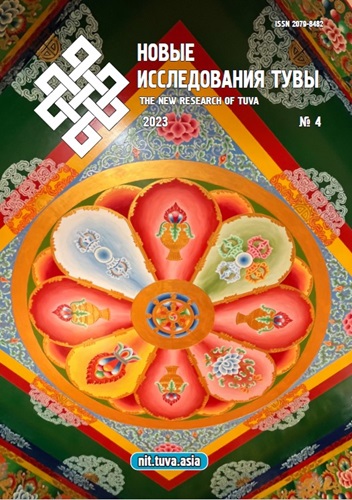Symbolism of the number seven in Tuvan linguoculture (in comparison with Turkic, Mongolian and Chinese languages)
DOI:
https://doi.org/10.25178/nit.2023.4.19Keywords:
Tuvan language; Tuvan folklore; Turkic languages; Mongolian language; Chinese language; numerical symbolism; numerical code; phraseology; paremiologyAbstract
The article conducts an analysis of Tuvan phraseological units and folklore texts featuring the numerical component “chedi” (seven). The research endeavors to scrutinize the symbolism inherent in the numeral “chedi” within phraseological constructs across diverse categories and folklore narratives within the Tuvan linguistic framework, contextualized against the backdrop of several Turkic, Mongolian, and Chinese languages. The selection of the number is substantiated by its distinct significance not only within the Tuvan linguistic milieu but also within the broader spectrum of the linguacultures under consideration. Notably, the number seven holds a distinctive position within Chinese linguacultural contexts. The study is predicated on an examination of materials comprising phraseological units, including proverbs, as well as instances extracted from folklore texts residing in the author's database. These materials were methodically derived through a comprehensive sampling methodology drawn from lexicographical sources encompassing Tuvan, Khakas, Altai, Mongolian, Buryat, Kalmyk, and Chinese languages.
Folklore narratives and phraseological units within the Tuvan linguacultural domain predominantly derive their thematic essence from the symbolism encapsulated in the number “chedi”, coupled with its sacrosanct character. This numerical representation encapsulates mythologized perspectives held by the Tuvan populace concerning temporal and spatial dimensions, concurrently expressing the conceptual underpinning of multiplicity, abundance, and symbolically aligning with the numerical counterpart “tos” (nine). A discernible congruence in the symbolism of the numeral seven emerges with the linguacultural milieus of the scrutinized Turkic and Mongolian ethnic groups. This affinity is explicable through the inherent relationship among Turkic and Mongolian languages within the Altaic language family, coupled with shared historical trajectories and the linguacultural transference characterizing the Tuvan, Mongol, and Buryat communities. The pervasive influence of Buddhism, along with its symbolic lexicon, is duly acknowledged. Notably, the numerical significance of seven assumes a heightened status among Mongolian ethnicities. A conjecture posited within the study posits that the symbolic representation of the numeral seven is intricately connected with mathematical considerations, as seven represents the largest prime number within the initial decadal sequence.
References
Abumova, O. D. (2013) Chislovaia simvolika v russkom i khakasskom iazykakh [Numerical symbols in Russian and Khakass languages]. Nauchnoe obozrenie Saiano-Altaia, no. 2 (6), pp. 3–6. (In Russ.).
Babueva, V. D. (2001) Mir traditsii buriat [The world of Buryat traditions]. Ulan-Ude, Ulzy. 144 p. (In Russ.).
Bakaeva, E. P. (2020) Pochitanie Bol'shoi Medveditsy v srede oiratov i kalmykov: drevneishie predstavleniia i buddiiskie naplastovaniia. Chast' 2 [Veneration of Ursa Major among the Oirats and Kalmyks: Ancient Beliefs and Later Buddhist Additions. Part 2]. Oriental Studies, vol. 13, no. 3, pp. 661–687. (In Russ.). DOI: https://doi.org/10.22162/2619-0990-2020-49-3-661-687
Basangova, T. G. (2019) Zhivotnye v kalmytskom fol'klore [Animals in Kalmyk folklore]. Elista, KalmGU. 192 p. (In Russ. and Kalm.).
Bredis, M. A. (2023) Simvolika chisla deviat’ v tuvinskoi lingvokul’ture (na fone riada tiurkskikh i mongol’skikh iazykov) [Symbolism of the number nine in Tuvan linguoculture (as compared to some Turkic and Mongolian languages)]. New Research of Tuva, no. 1, pp. 228–242. (In Russ.). DOI: https://doi.org/10.25178/nit.2023.1.13
Bredis, M. A., Dimoglo, M. S. and Lomakina, O. V. (2020) Paremii v sovremennoi lingvistike: podkhody k izucheniiu, tekstoobrazuiushchii i lingvokul'turologicheskii potentsial [Paremias in Modern Linguistics: Approaches to Study, Text-Forming and Linguocultural Potential]. RUDN Journal of Language Studies, Semiotics and Semantics, vol. 11, no. 2, pp, 265–284. (In Russ.). DOI: https://doi.org/10.22363/2313-2299-2020-11-2-265-284
Bredis, M. A. and Ivanov, E. E. (2022) Lingvokul'turologicheskii kommentarii v polilingval'nykh slovariakh poslovits [Linguoculturological commentary in polylingual dictionaries of proverbs]. Voprosy leksikografii, no. 26, pp. 5–30. (In Russ.). DOI: https://doi.org/10.17223/22274200/25/1
Bredis, M. A., Lomakina, O. V., Borisova, A. S. and Lazareva, O. V. (2022) Chislovoi kod tuvinskoi lingvokul’tury v poslovitsakh (na fone riada tiurkskikh i mongol’skikh iazykov narodov Rossii) [Numerical code of Tuvan linguistic culture in proverbs (as contrasted to a number of Turkic and Mongolian languages of the peoples of Russia)]. New Research of Tuva, no. 4, pp. 276–293 (In Russ.). DOI: https://doi.org/10.25178/nit.2022.4.20
Bredis, M. A., Lomakina, O. V. and Mokienko, V. M. (2021) Chislovoi kod rusinskoi kul'tury (na frazeologicheskom materiale) [Numerical code of the Rusyn culture (based on phraseological material)]. Kognitivnye issledovaniia iazyka, no. 2 (45), pp. 202–212. (In Russ.).
Bredis, M. A. and Novospasskaya, N. V. (2023) Osobennosti upotrebleniia numerativa piat’ v tuvinskoi lingvokul’ture (na fone riada tiurkskikh i mongol’skikh iazykov) [Features of the use of the numeral five in Tuvan linguoculture (as contrasted to a number of Turkic and Mongolian languages)]. New Research of Tuva, no. 3, pp. 36–50. (In Russ.). DOI: https://doi.org/10.25178/nit.2023.3.3
Burykin, A. A. (2004) Chisla v poetike «Dzhangara» [Numbers in the poetics of “Jangar”]. Mongolovedenie, issue 3, pp. 103–119. (In Russ.).
Burykin, A. A. (2020) Buddiiskie motivy v fol'klore (na materiale kalmytskikh, tuvinskikh i buriatskikh epicheskikh proizvedenii i bogatyrskikh skazok) [Buddhist motifs in folklore: the case of Kalmyk, Tuvan and Buryat epics and heroic tales]. New Research of Tuva, no. 3, pp. 189–209. (In Russ.). DOI: https://doi.org/10.25178/nit.2020.3.14
Garmaeva, A. E. (2008) Chislovaia simvolika v mongol'skom iazyke: semantika i funktsii [Numerical symbolism in the Mongolian language: Semantics and functions]. Vestnik Buriatskogo gosudarstvennogo universiteta, no. 10, pp. 105–110. (In Russ.).
Grebnev, L. V. (1960) Tuvinskii geroicheskii epos (opyt istoriko-etnograficheskogo analiza) [Tuvan heroic epos (experience of historical and ethnographic analysis)]. Moscow, Vost. Lit. 145 p. (In Russ.).
Di Iaoguang (2016) Sopostavitel'nyi analiz ustoichivykh sochetanii s komponentom «sem' — qi» v russkom i kitaiskom iazykakh [Comparative analysis of stable combinations with the “seven — qi” component in Russian and Chinese]. Filologicheskie nauki. Voprosy teorii i praktiki, no. 5 (59): in 3 parts. Part 2, pp. 83–86. (In Russ.).
Zhukovskaia N. L. (2002) Kochevniki Mongolii : Kul'tura. Traditsii. Simvolika [Nomads Of Mongolia: Culture. Traditions. Symbolism]. Moscow, Vostochnaia literatura. 247 p. (In Russ.).
Zinovieva, E. I. and Alyoshin, A. S. (2022) Sem'ia v komparativnykh paremiiakh tuvinskogo, shvedskogo i russkogo iazykov [The family in comparative paremies of Tuvan, Swedish and Russian languages]. New Research of Tuva, no. 1, pp. 131–145. DOI: https://doi.org/10.25178/nit.2022.1.9
Ivanov, Eu. Eu. (2022) Semanticheskaia tipologiia tuvinskikh poslovits (empiricheskii i aksiologicheskii aspekty) [Semantic typology of Tuvan proverbs (empirical and axiological aspects)]. New Research of Tuva, no. 4, pp. 317–337. (In Russ.). DOI: https://doi.org/10.25178/nit.2022.4.22
Ivanov, Eu. Eu. (2023) Lingvokul’turologicheskii kommentarii v tuvinsko-russko-angliiskom paremiologicheskom slovare [Linguoculturological commentary in the Tuvan-Russian-English Paremiological Dictionary]. New Research of Tuva, no. 1, pp. 243–258. (In Russ.). DOI: https://doi.org/10.25178/nit.2023.1.13
Ivanov, E. E., Lomakina, O. V. and Petrushevskaia, Yu. A. (2021) Natsional'naia spetsifichnost' poslovichnogo fonda (osnovnye poniatiia i metodika vyiavleniia) [The ethnic character of the proverbial corpus: basic concepts and procedure for identification]. RUDN Journal of Language Studies, Semiotics and Semantics, vol. 12, no. 4, pp. 993–1032. (In Russ.). DOI: https://doi.org/10.22363/2313-2299-2021-12-4-996-1035
Ivanov, E. E., Marfina, Zh. V. and Shkuran, O. V. (2022) Nominatsii zhivotnykh v tuvinskikh poslovitsakh i pogovorkakh: aspekty realizatsii i problematika izucheniia [Animal nouns in Tuvan proverbs and sayings: problems of studying and aspects of functioning]. New Research of Tuva, no. 1, pp. 47–68. (In Russ.). DOI: https://doi.org/10.25178/nit.2022.1.4
Iksarova, M. N. (2021) Mesto bozhestv Severnogo Kovsha v kitaiskoi sisteme verovanii (na primere 北斗七真君) [The place of the deities of the Northern Ladle in the Chinese belief system (for example 北斗七真君)]. Kul'turnyi kod, no. 3, pp. 7–14. (In Russ.). DOI: https://doi.org/10.36945/2658-3852-2021-3-7-14
Kara-ool, L. S. (2019) Chislitel'nye v toponimakh Tuvy [Numerals in Toponyms of Tuva]. Oriental Studies, no. 4, pp. 691–706. (In Russ.). DOI: https://doi.org/10.22162/2619-0990-2019-44-4-691-706
Kenin-Lopsan, M. B. (2021) Traditsionnaia kul'tura tuvintsev [Traditional culture of the Tuvans]. Kyzyl, Raduga Tuvy ; Tuvan Book Publishing House. 232 p. (In Russ.).
Kul'ganek, I. V. (2017) Mongol'skie poslovitsy i pogovorki. Issledovanie, perevod, kommentarii [Mongolian proverbs and sayings. Research, translation, commentary]. St. Petersburg, Peterburgskoe Vostokovedenie. 184 p. (In Russ.).
Kurbatskii, G. N. (2001) Tuvintsy v svoem fol'klore (istoriko-etnograficheskie aspekty tuvinskogo fol'klora) [Tuvans in their folklore: Historical and ethnographic aspects of Tuvan folklore)]. Kyzyl, Tuva book publishing house. 464 p. (In Russ.).
Lomakina, O. V. (2022) Tuvinskaia paremiologiia: lingvokul'turologicheskii i lingvoaksiologicheskii potentsial [Tuvan paremiology: its linguoculturological and linguoaxiological potential]. New Research of Tuva, no. 1, pp. 6–16. (In Russ.). DOI: https://doi.org/10.25178/nit.2022.1.1
Lomakina, O. V. (2011) Frazeologizmy i poslovitsy kak smyslovye dominanty khudozhestvennogo teksta (na materiale proizvedenii L. N. Tolstogo) [Phraseological units and proverbs as semantic dominants of a literary text (based on the material of L. N. Tolstoy's works)]. Voprosy filologii, no. 2, pp. 67–72. (In Russ.).
Mizhit, E. B. (2010) Tuvinskaia traditsionnaia kosmologiia v geroicheskom epose [Tuvan Traditional Cosmology in the Heroic Epic]. New Research of Tuva, no. 1, pp. 149–172. (In Russ.).
Mongush, M. V. (1992) Lamaizm v Tuve: istoriko-etnograficheskoe issledovanie [Lamaism in Tuva: a historical and ethnographic study]. Kyzyl, Tuvan book publisher. 144 p. (In Russ.).
Moskvitheva, S. A., Aleksandrova, O. I. and Ebzeeva, Yu. N. (2022) Fol'klornye kul'turemy i struktura kul'turnykh reprezentatsii tuvintsev [Folklore culturemes in the structure of cultural representations of Tuvan people]. New Research of Tuva, no. 1, pp. 164–182. DOI: https://doi.org/10.25178/nit.2022.1.11
Nam, E. V. (2016) Rol' chislovoi simvoliki v shamanskoi kosmologii i v protsesse kommunikatsii mezhdu mirami (na materialakh sibirskogo regiona) [The role of numerical symbolism in shamanic cosmology and in the process of communication between worlds (based on materials from the Siberian region)]. Vestnik Kemerovskogo gosudarstvennogo universiteta, no. 1 (65), pp. 29–33. (In Russ.).
Neliubova, N. Yu. (2022) Aksiologicheskie dominanty paremii kak tipologicheskie markery tuvinskoi, russkoi i frantsuzskoi etnokul'tur [Axiological dominants of paremies as typological markers in Russian, Tuvan and French ethnic cultures]. New Research of Tuva, no. 1, pp. 146–163 (In Russ.). DOI: https://doi.org/10.25178/nit.2022.1.10
Oinotkinova, N. R. (2012) Altaiskie poslovitsy i pogovorki: poetika i pragmatika zhanrov [Altai proverbs and sayings: poetics and pragmatics of genres]. Novosibirsk, In-t filologii. 354 p. (In Russ.).
Oinotkinova, N. R. (2021) Mifologicheskaia kartina mira altaitsev: kontsepty, motivy, siuzhety [Mythological picture of the Altaians' world: concepts, motives, plots]. Novosibirsk, IPTs NGU. 622 p. (In Russ.).
Orus-ool, S. M. (2020) Mify, legendy i predaniia tuvintsev-todzhintsev [Myths, legends and legends of the Tuvan-Todzhin people]. Kyzyl, Detskii literaturnyi sait «Raduga Tuvy». 80 p. (In Russ.).
Paremiologiia bez granits [Paremiology without borders] (2020) / ed. by M. A. Bredis and O. V. Lomakina. Moscow, RUDN Publ. 244 p. (In Russ.).
Paremiologiia na perekrestkakh iazykov i kul'tur [Paremiology at the crossroads of languages and cultures] (2021) / M. A. Bredis et al.; ed. by E. E. Ivanov and O. V. Lomakina. Moscow, RUDN Publ. 246 p. (In Russ.).
Petrushevskaya, J. A. (2022) Tuvinskie i belorusskie poslovichnye paralleli (tipologicheskaia obshchnost’ na fone etnokul’turnoi spetsifichnosti) [Tuvan and Belarusian proverbial parallels (typological community amid ethnocultural specificity)]. New Research of Tuva, no. 3, pp. 241–263. (In Russ.). DOI: https://doi.org/10.25178/nit.2022.3.16
Popov, V. A. and Burykin, A. A. (2019) Kalmytskaia terminologiia rodstva kak otrazhenie istoricheskikh sviazei i etnokul'turnykh kontaktov Oiratskogo mira i tuvintsev [Kalmyk kinship terminology as a reflection of historical ties and ethnocultural contacts between the Oirat world and Tuvans]. New Research of Tuva,
no. 4, pp. 4–17. (In Russ.). DOI: https://doi.org/10.25178/nit.2019.4.1
Piurbeev, G. Ts. (2015) Epos «Dzhangar»: Kul'tura i iazyk (Etnolingvisticheskie etiudy) [The epic “Dzhangar”: Culture and language (Ethnolinguistic studies).]. Elista, KIGI RAN. 300 p. (In Russ. and Kalm.).
Samdan, Z. B. (2016) Mif v fol'klornoi traditsii tuvintsev (formy bytovaniia, siuzhetnyi sostav, sistema personazhei) [Myth in the folklore tradition of Tuvinians (forms of existence, plot composition, character system)]. Novosibirsk, Nauka. 180 p. (In Russ.).
Sravnitel'no-istoricheskaia grammatika tiurkskikh iazykov. Leksika [A comparative historical grammar of Turkic languages. Vocabulary] (2001) / E. R. Tenishev, G. F. Blagova, I. G. Dobrodomov et al. ; ed. by E. R. Tenishev. 2nd ed, enlarged. Moscow, Nauka Publ. 822 p. (In Russ.).
Subrakova, O. V. (2005) Sakral'nye chisla khakasskogo eposa [Sacred numbers of the Khakass epic]. In: Chatkhan: istoriia i sovremennost' [Chatkhan: History and modernity]. Materials of the II International Symposium on Chathanna Music and Throat Singing / ed. by L. V. Anzhiganova. Abakan, Khakass Book Publishing House. 112 p. Pp. 100–104. (In Russ.).
Tagarova, T. B. (2011) K lingvokul'turologicheskomu opisaniiu buriatskikh frazeologicheskikh edinits s chislitel'nymi [To the linguoculturological description of Buryat phraseological units with numerals]. In: Uchenye zapiski Zabaikal'skogo gosudarstvennogo gumanitarno-pedagogicheskogo universiteta im. N. G. Chernyshevskogo. Ser. Filologiia, istoriia, vostokovedenie, no. 2 (37), pp. 112–117. (In Russ.).
Titarenko, M. L. (2007) Dukhovnaia kul'tura Kitaia [Spiritual Culture of China] : an encyclopedia : in 5 vol. / ed. by M. L. Titarenko. Moscow, Vostochnaia literatura. Vol. 2. Mifologiia. Religiia / ed. by M. L. Titarenko et al. 869 p. (In Russ.).
Khuan Tsinkhua (2010) Simpatiia i antipatiia k chislam v russkoi i kitaiskoi kul'turakh [Sympathy and antipathy to numbers in Russian and Chinese cultures]. Vestnik Moskovskogo gosudarstvennogo oblastnogo universiteta. Seriia: Lingvistika, no. 3, pp. 138–144. (In Russ.).
Tsengel’skie tuvintsy: fol’klor i literatura [Tsengel Tuvans: Folklore and literature] (2020) / U. A. Dongak et al., ed. by G. Zolbaiar and B. Baiarsaikhan. Novosibirsk, Nauka. 152 p. (In Russ.).
Chugunekova, A. N. (2019a) Simvolika chisel v khakasskoi i tuvinskoi paremiologii [Symbolism of numbers in Khakass and Tuvan paremiology]. Mezhdunarodnyi zhurnal gumanitarnykh i estestvennykh nauk, no. 10–2(37), pp. 18–21. (In Russ.).
Chugunekova, A. N. (2019b) Simvolika chisel v khakasskom i tuvinskom iazykakh (na materiale fol'klornykh tekstov) [Symbolism of numbers in the Khakass and Tuvan languages (based on folklore texts)]. Filologicheskie nauki. Voprosy teorii i praktiki, vol. 12, issue 11, pp. 432–436. (In Russ.).
Sharaeva, T. I. And Aiyzhy, E. V. (2019) Chai v traditsionnoi kul'ture kalmykov i tuvintsev [Tea in the traditional culture of the Kalmyks and Tuvans]. New Research of Tuva, no. 4, pp. 140–153. (In Russ.). DOI: https://doi.org/10.25178/nit.2019.4.12
Published
How to Cite
For citation:
Bredis M. A. and Xue B. Simvolika chisla sem’ v tuvinskoi lingvokul’ture (na fone riada tiurkskikh, mongol’skikh i kitaiskogo iazykov) [Symbolism of the number seven in Tuvan linguoculture (in comparison with Turkic, Mongolian and Chinese languages)]. New Research of Tuva, 2023, no. 4, pp. 274-289. DOI: https://doi.org/10.25178/nit.2023.4.19
Issue
Section

This work is licensed under a Creative Commons Attribution-NonCommercial 4.0 International License.

Author(s) license holder(s) grant rights for their work to the journal (grantee of a license) under the simple non-exclusive open license in accordance with Art. 1286.1 «Open license for a research work, work of literature or fine arts», Civil Code of the Russian Federation.
New Research of Tuva publishes articles under the Creative Commons Attribution-NonCommercial license (CC BY-NC).
Since it is an open license, author(s) reserve the right to upload the article to their institutional repository, submit it to another journal (if it allows republications), or republish it on their own website (in full, or in part).
However, several conditions apply here:
a) The republished version must always contain the name(s) and affiliation(s) of the author(s), the original title and the hyperlink to the original version on the New Research of Tuva website;
b) It must be in open access, free of charge, and no category of readers must be in any way whatsoever advantaged over general readership.
c) should the contribution be submitted elsewhere by its author(s) without substantial modification (30% or more of original text unchanged), the body of the article should contain a disclaimer that the original version was published in New Research of Tuva (with a link to the respective page)
The CC-BY-NC is a non-revocable license which applies worldwide and lasts for the duration of the work’s copyright.










